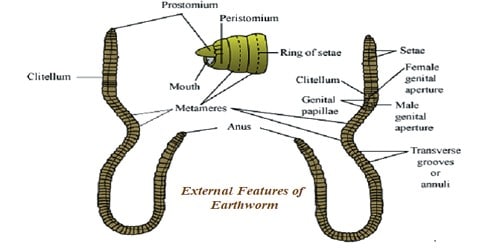Earthworms are nocturnal animals. Generally, they have a reddish-brown color with a cylindrical body. They lie in the burrows during the day and come out at night for food. The body is segmented and there are about 100 to 120 metameres or short segments.
Earthworm
- Phylum: Annelida
- Class: Chaetopoda
- Order: Oligochaeta
- Type: Lampito mauritii
Earthworms leave the burrow only during the rainy season when their burrows are flooded with water. There is a dark median mid-dorsal blood vessel that is seen on the dorsal exterior of the body. The ventral surface of the body has genital openings or pores.
External features: Lampito (Megascolex) mauritii is a common earthworm found in South India. The body is long, slender, cylindical and bliaterally symmetrical. It is about 8 to 21 cm long and 3 to 4 mm in thickness. The dorsal surface is dark purplish brown, and the ventral surface is paler in color. It is marked by a series of segments. The segments are separated from one another by inter-segmental grooves. The division is both external and internal. Inside the body, each cavity of the segment is separated from the next, by a thin partition called the septum. All the segments look alike. This kind of repetitive ar-rangement of the segments is called metamerism.

Shape: Earthworm is elongated, long, thin, cylindrical or vermiform shaped. Its body shape is well suited for burrowing tendency. Its anterior end is faintly pointed whereas the posterior end is blunt. The anterior end is tapering while the posterior end is more or less blunt.
Body surface: Body consists of dorsal and ventral surfaces.
Size: A mature worm measures about 150 mm in length and 3-5 mm in width.
Eyes: No eyes instead of eyes phasomes act as a photoreceptor.
Color: The dorsal surface of the body is dark brown in color due to the incidence of the pigment called porphyrin. The dorsal surface also carries a dark-colored centerline which is due to the occurrence of a dorsal blood vessel which is seen through the integument.
Body segmentation: The segments are divided outwardly by intersegmental grooves and internally by corresponding intersegmental septa. The outside segmentation corresponds with the internal segmentation. New segments are created from the germinal zone located in front of the pygidium. Hence the old segments are at the anterior and the new segments are created at the posterior end.
Head: Earthworm does not have a separate head and also sense organs like eyes, cirri, tentacles are absent. The first segment of the body at the anterior end is called the buccal segment or peristomium. Peristomium bears terminal, crescentic mouth.
The mouth is found in the center of the first segment of the body, called the peristomium. Overhanging the mouth is a small flap called the upperlip or prostomium. The last segment has an anus. It is called the pygidium. In mature worms, segments 14 to 17 may be found swollen with a glandular thickening of the skin called clitellum.
Body setae: Tiny curved bristles called setae are found embedded in small pits of the body wall. These pits are called the setigerous pits. The setae are arranged around the body. They are made of chitin and have a swollen middle part and pointed curved ends. The setae resemble the mathematical symbol ∫. They can be moved in any direction and extended or withdrawn by the action of muscles. They are used for locomotion.











